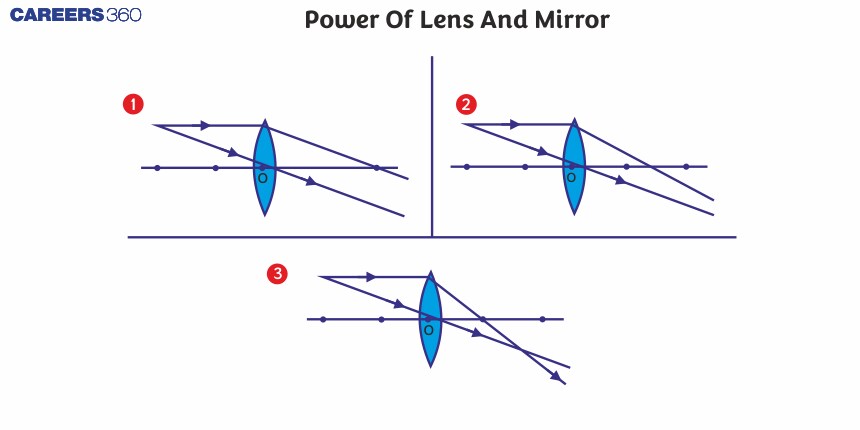Power Of Lens And Mirror
The power of a lens or mirror is a fundamental concept in optics that quantifies their ability to converge or diverge light rays. For lenses, power is determined by the curvature of the lens surfaces and the refractive indices of the materials involved, while for mirrors, it is influenced by their shape and focal length. The power, measured in diopters for lenses and inverse meters for mirrors, plays a crucial role in designing optical devices such as eyeglasses, microscopes, and telescopes. In real life, understanding and calculating lens and mirror power helps in correcting vision problems, magnifying distant objects, and capturing clear images in cameras. This concept is also pivotal in everyday devices like binoculars and contact lenses, where precise control of light is essential for effective vision correction and image clarity. In this article, we will cover the definition of Power, formulas and some solved examples for better understanding.
JEE Main/NEET 2027: Physics Important Formulas for Class 10
NEET 2025: Mock Test Series | Syllabus | High Scoring Topics | PYQs
JEE Main: Study Materials | High Scoring Topics | Preparation Guide
JEE Main: Syllabus | Sample Papers | Mock Tests | PYQs
- Power of Lens and Mirror
- Solved Example Based on Power of Lens and Mirror
- Summary

Power of Lens and Mirror
The power of a lens or mirror is a fundamental measure in optics that quantifies their ability to bend light rays. It directly relates to their focal length and is crucial for understanding and designing optical systems.
The power of a lens is defined as the reciprocal of focal length and the Power of a mirror is defined as the negative reciprocal of focal length.
So,
$
P_{\text {Lens }}=\frac{1}{f} \quad \text { and } \quad P_{\text {Mirror }}=\frac{-1}{f}
$
Where, $f=$ focal length
- The unit of power is Diopter, 1D = 1 m-1
The sign of the focal length will be taken according to the sign convention which we have discussed in the previous concept.
The power of a combination of lenses in contact is the algebraic sum of the powers of individual lenses, so it can be written as
$P_{\text {Total }}=P_I+P_2+P_3+\cdots+P_n$
Recommended Topic Video
Solved Example Based on Power of Lens and Mirror
Example 1: One plano-convex and one plano-concave lens of the same radius of curvature 'R' but of different materials are joined side by side as shown in the figure. If the refractive index of the material of 1 is $\mu_1$ and that of 2 is $\mu _{2}$$\mu_2$ , then the focal length of the combination is:
1) $\frac{R}{\mu_1-\mu_2}$
2) $\frac{2 R}{\mu_1-\mu_2}$
3) $\frac{R}{2\left(\mu_1-\mu_2\right)}$
$
\frac{R}{4)^{2-\left(\mu_1-\mu_2\right)}}
$
Solution:
For lens 1
$
\frac{1}{f_1}=\left(\mu_1-1\right)\left(\frac{1}{\infty}-\frac{1}{-R}\right)
$
For lens 2
$
\begin{aligned}
\frac{1}{f_2} & =\left(\mu_2-1\right)\left(\frac{1}{-R}-\frac{1}{\infty}\right) \\
\frac{1}{f_e q} & =\frac{1}{f_1}+\frac{1}{f_2} \\
& =\frac{\mu_1-1}{R}+\frac{1-\mu_2}{R} \\
f_{e q} & =\frac{R}{\mu_1-\mu_2}
\end{aligned}
$
Hence, the answer is the option (1).
Example 2: A person cannot see distinctly at a distance of less than one metre. Calculate the power of the lens that he should use to read a book at a distance of 25 cm. Give your answer in Dioptre.
1) 3
2) 0.125
3) -3
4) 4
Solution:
The power of the lens is expressed as :
$\begin{aligned} & P=\frac{1}{f}=\frac{1}{v}-\frac{1}{u} \\ & -\frac{1}{100}+\frac{1}{25}=\frac{3}{100}=+3 D\end{aligned}$
Hence, the answer is the option (1).
Example 3: A double convex lens has power P and the same radii of curvature R of both surfaces. The radius of curvature of the surface of a plano-convex lens made of the same material with power 1.5 P is :
1) $2 R$
2) $\frac{R}{2}$
3) $\frac{3 R}{2}$
4) $\frac{R}{3}$
Solution:

$
\begin{aligned}
& \quad \mathrm{R}_1=\mathrm{R}_2=\mathrm{R} \\
& \text { Power }=P
\end{aligned}
$
Refractive index is assume $\left(\mu_l\right)$
$
\mathrm{P}=\frac{1}{\mathrm{f}}=\left(\mu_l-1\right)\left(\frac{2}{\mathrm{R}}\right)
$

$\begin{aligned} & \mathrm{P}^{\prime}=\frac{1}{\mathrm{f}^{\prime}}=\left(\mu_{\ell}-1\right)\left(\frac{1}{\mathrm{R}^{\prime}}\right) \\ & P^{\prime}=\frac{3}{2} P \\ & \left(\mu_{\ell}-1\right)\left(\frac{1}{\mathrm{R}^{\prime}}\right)=\frac{3}{2}\left(\mu_{\ell}-1\right)\left(\frac{2}{\mathrm{R}}\right) \\ & \therefore \quad \mathrm{R}^{\prime}=\frac{\mathrm{R}}{3}\end{aligned}$
Hence, the answer is the option (4).
Example 4: A person has been using spectacles of power −1.0 dioptre for distant vision and a separate reading glass of power 2.0 dioptres. What is the least distance of distinct vision for this person :
1) 40 cm
2) 30 cm
3) 10 cm
4) 50 cm
Solution:
Power convex lens = 2.0 D
Power of concave lens = –1.0 D
$x \rightarrow$ the least distance of distinct vision
$
\begin{aligned}
& \mathrm{f}=\frac{1}{2} \times 100=50 \mathrm{~cm} \\
& \frac{1}{\mathrm{f}}=\frac{1}{\mathrm{v}}-\frac{1}{\mathrm{u}} \\
& \frac{1}{50}=\frac{1}{(-\mathrm{x})}-\frac{1}{-25} \Rightarrow \frac{1}{50}-\frac{1}{25}=\frac{1}{(-\mathrm{x})} \\
& \Rightarrow \quad \frac{1-2}{50}=\frac{-1}{\mathrm{x}} \\
& \Rightarrow x=50 \mathrm{~cm}
\end{aligned}
$
Hence, the answer is the option (4).
Example 5: The nearer point of the hypermetropic eye is 40 cm. The lens to be used for its correction should have the power:
$
\text { 1) }+1.5 \mathrm{D}
$
2)-1.5 D
3) +2.5 D$
4) +0.5 D$
Solution:
Hypermetropia is correct by using a convex lens. The focal length of the lens used, f=+ve (defective near point)$\begin{aligned} \mathrm{f}=+\mathrm{d}=+40 \mathrm{~cm} \\ \therefore \quad \text { Power of lens }=\frac{100}{f(\mathrm{~cm})}=\frac{100}{+40}=+2.5 \mathrm{D}\end{aligned}$
Hence, the answer is the option (3).
Summary
The power of a lens or mirror is a crucial concept in optics that measures their ability to converge or diverge light, expressed in diopters for lenses and inverse meters for mirrors. It is defined as the reciprocal of the focal length for lenses and the negative reciprocal for mirrors. This principle is vital for designing optical devices like eyeglasses, microscopes, and telescopes. Practical examples demonstrate how to calculate the power needed for vision correction, the effects of combining lenses, and the relationship between focal lengths and lens curvature. Understanding these calculations helps in optimizing optical devices for clear vision and accurate image formation.

